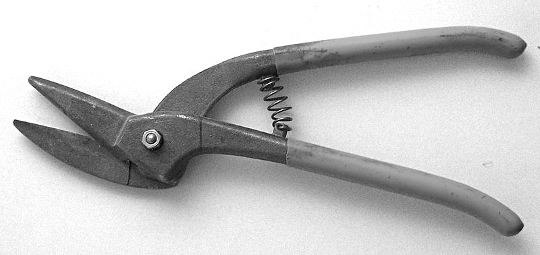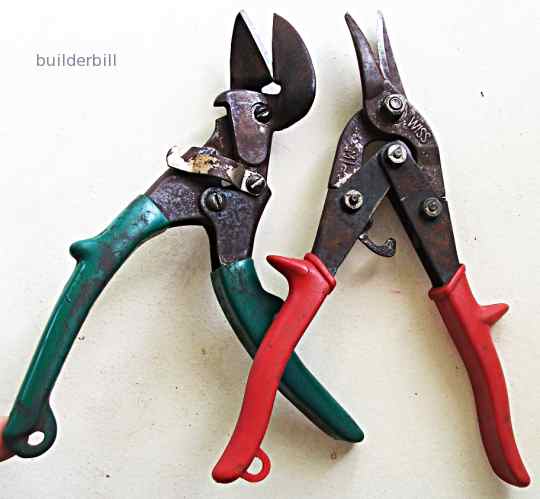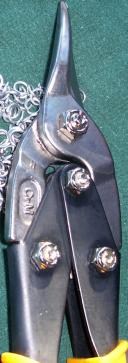 |
||||||||||
Graphical Construction Glossary >> Tools. >> Hand Tools >> Tin Snips
Hand operated snips
Above is a set of snips that are standard with no frills.They are similar in their action the home scissors or shears. They are basically two pieces of metal with a joint and a bolt. They are simple opposed levers. The handles are longer than the cutting faces and so leverage is applied when cutting. Snips in general are used for cutting thin material. Say 0.9 and 1.2mm thick. Every now and again we have to cut something heavier, for example the thick metal straps around packs of timber. It is then that a pair of these strong and simple tin snips come into their own. I never use the good snips below for anything but working with roofing flashings. (I don't lend them to anyone else either).
More convenient for some jobs are Offset Snips These are more comfortable to use when doing a lot of long cuts. The offset keeps the knuckles a little higher. A furthe point is that the snips are sprung, it is easy to see that letting the spring do the work of opening the jaws will save fatigue on long jobs.
The snips in the photos here are sometimes called Aviation Snips. They have a compound action that increases the power of the cut. That is there are an extra set of hinged joints that are extra levers. So we have a short and comfortable handle that is as powerful as one that is a lot longer. Again they are sprung so that they return to open on their own. For storage there is a small clip that keeps them closed. Looking at the two sets of snips above, it can easily be seen that the set with the red handle is straighter. These are for standard cutting and they are easier to get into smaller places. The green handle one can be seen to have an offset to the handles. This is for easier use around profiled sheets, say corrugated iron. A less noticeable difference is the fact that when in the cutting position one set of these snips cuts straight to the right hand side and leaves the curly offcut to the left. These are right handed snips. The other set cuts with the waste material to the right. I am right handed, so I use the red handled snips most of the time, doing the cutting with the right hand and lifting uo and away the curling offcut with the left hand. The green snip have to be used now and again as it is all about the position of the cut and the offcut or waste. The yellow handles, on the right makes a cut with no bias to either side. There is a further type similar to the Makita snips below that has two fixed arms that have a movable one inbetween. These are commonly known as Packing Case Snips. You can see a power version on the power snips page. This is the reason for the colours, to quickly identify which type, left handed, right handed or straight. If you didn't find exactly what you are looking for try this search tool that will search the site and the web. "What can be added to the happiness of a man who is in health, out of debt, and has a clear conscience? "When we build, let us think that we build for ever."John Ruskin 1819-1900 |
Hire Equipment  Furniture Fittings - Architectural Hardware - Electronic Locking Systems - Technical Hardware BuilderBill sponsorship Glossary Pages.Roof Glossary and Roofing Formwork Glossary and other tempory work. Hand Tools Glossary Power Tools Glossary Asbestos Glossary Woodwork Glossary Stair Glossary Concrete Glossary Masonry Glossary doors Glossary BuilderBill Books Building Maths  Stair Design  Asbestos Book |
|||||||||
|
|
||||||||||
|
Please Note! The information on this site is offered as a guide only! When we are talking about areas where building regulations or safety regulations could exist,the information here could be wrong for your area. It could be out of date! Regulations breed faster than rabbits! You must check your own local conditions. Copyright © Bill Bradley 2007-2012. All rights reserved. |
||||||||||



